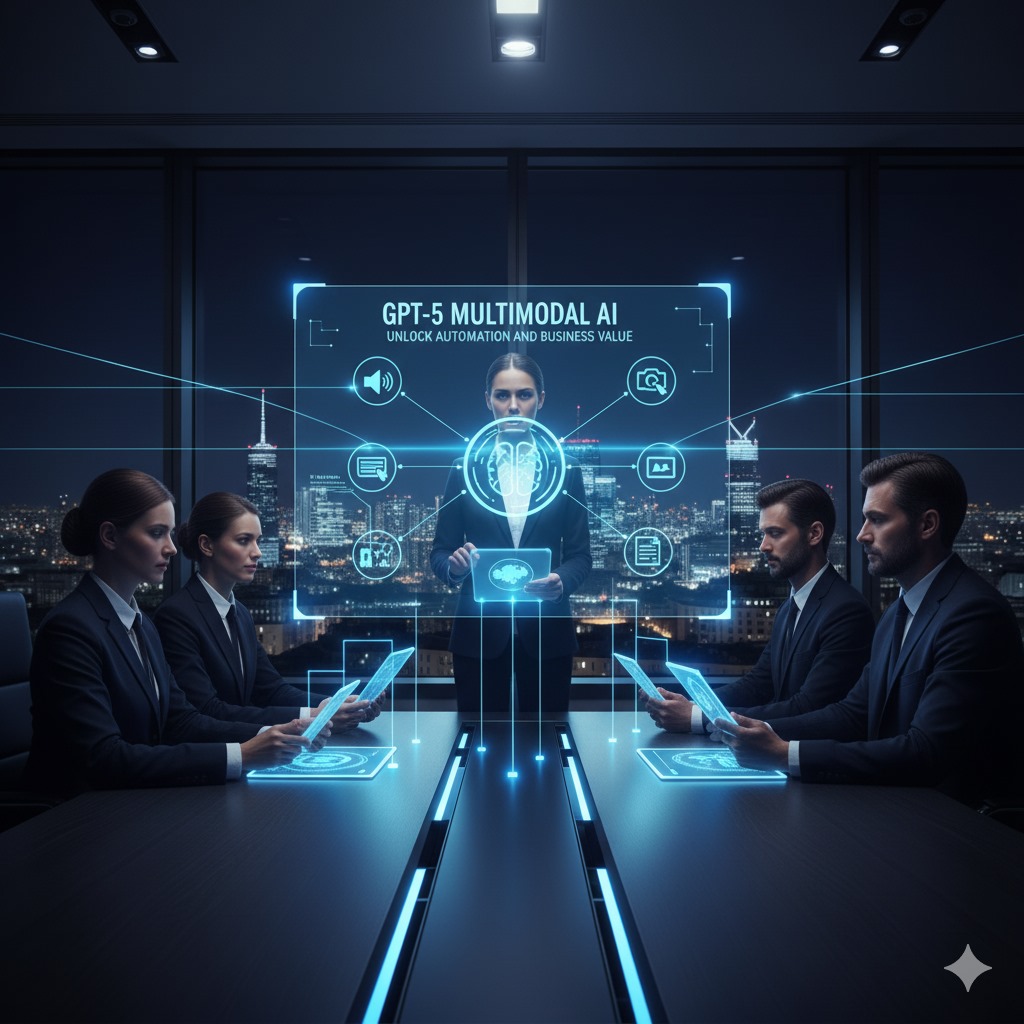Overview: What GPT-5 Means for Business
OpenAI has released GPT-5, a next-generation model that offers advanced multimodal reasoning across text, images, and audio, according to OpenAI and press coverage [1][2]. For business leaders, this release marks a shift: models that can natively reason across multiple input types open new automation and product opportunities while raising governance and integration questions.
Key Capabilities (from the release)
Multimodal reasoning
The defining feature reported for GPT-5 is its advanced multimodal reasoning, enabling the model to process and reason across text, images, and audio inputs [1][2]. That capability moves beyond single-modality assistants and allows unified handling of diverse data in a single model.
Implications for AI-driven automation
Because GPT-5 natively spans modalities, businesses can automate workflows that previously required separate systems or complex pipelines. Examples include unified customer support that understands typed messages, voice clips, and screenshots; automated triage for visual and audio evidence; and content workflows that combine text and media into publishable outputs.
Practical Business Applications
Customer experience and support
- Multichannel support: A single assistant can accept a screenshot, a voice message, or typed text and provide a coherent response or next steps.
- Faster resolution: Agents can receive synthesized summaries from multimodal inputs to reduce handling time and improve first-contact resolution.
Product innovation
- New interaction models: Products can accept audio commands, image uploads, and text prompts without stitching together separate AI components.
- Enhanced content generation: Teams can generate multimodal marketing assets or product documentation by combining textual instructions with images and audio inputs.
Operational automation
- Automated inspection and reporting: Image inputs (photos of equipment) plus voice notes (technician comments) can be analyzed together to create structured reports and prioritized action items.
- Compliance and monitoring: Multimodal ingestion allows monitoring of diverse evidence sources in regulated workflows where both documents and media matter.
Actionable Steps for Leaders: Evaluate and Pilot
Below is a prioritized, practical roadmap to evaluate GPT-5 and capture business value while limiting risk.
1. Identify high-impact multimodal use cases
- Map workflows where text, images, and audio are already used together (e.g., field service, support, insurance claims).
- Prioritize use cases by business value: cost reduction, revenue enablement, customer satisfaction, or compliance risk reduction.
2. Run focused pilots
- Prototype with representative data and limited scale to validate technical fit and ROI.
- Define clear success metrics: accuracy, time saved, cost per interaction, or conversion uplift.
3. Design integration architecture
Choose between direct API integration and hybrid architectures that combine GPT-5 with existing systems:
- API-first approach: Connect product or support flows directly to the model for multimodal requests and responses.
- Pipeline approach: Use lightweight pre-processing (e.g., image cropping, audio denoising) before passing content to the model and post-processing to enforce business rules.
4. Data governance and privacy
- Classify data: Identify PHI/PII and sensitive content in images, audio, and text.
- Apply controls: Implement encryption, access restrictions, and retention policies that align with regulatory needs.
5. Operationalize monitoring and safety
- Establish performance monitoring for multimodal inputs to detect drift or failure modes.
- Build human-in-the-loop (HITL) checkpoints for high-risk decisions and continuous model evaluation.
Implementation Checklist: From Pilot to Production
Technical checklist
- APIs and SDKs: Verify SDK availability and compatibility with your stack.
- Latency and throughput: Measure model response times for multimodal payloads in pilot scenarios.
- Pre-/post-processing: Implement standardized preprocessing for images and audio for consistent inputs.
Business checklist
- Cost modeling: Estimate per-request costs and infrastructure overhead for production usage.
- Compliance review: Run legal and privacy assessments when handling regulated data.
- User training: Prepare internal teams and document workflows for agents and users interacting with the system.
Risks, Limitations, and Governance
Known and typical model risks
- Over-reliance: Treat model outputs as assistive, not infallible; use HITL for critical decisions.
- Ambiguity across modalities: Combining noisy audio or low-quality images with text can produce uncertain outputs; implement quality checks.
- Data leakage and privacy: Multimodal content often contains sensitive details; enforce strict data controls.
Governance best-practices
- Define clear accountability for model decisions and for who can deploy updates.
- Maintain audit logs of multimodal requests and responses to support traceability and compliance.
- Set performance SLAs and rollback procedures if model behavior degrades.
Illustrative Example Scenarios
Field service automation (illustrative)
Technicians submit a photo of a faulty part plus a brief voice note describing symptoms. A multimodal model synthesizes a diagnosis, suggests spare parts, and creates a prioritized work order. This reduces time to diagnosis and administrative overhead.
Claims triage for insurers (illustrative)
Claim submissions often include photos (damaged property), voice statements, and text descriptions. A single multimodal model can extract structured facts, flag high-risk claims, and route cases for human review more efficiently than chained single-modality systems.
Next Steps for Business Leaders
- Confirm that multimodal capabilities align with your roadmap and identify top 2–3 pilots.
- Engage legal and security teams early to scope data controls for images and audio.
- Invest in evaluation metrics for multimodal performance and user experience.
- Plan for scaling: define cost, hardware, and monitoring requirements before broad rollout.
Conclusion
GPT-5’s reported advanced multimodal reasoning across text, image, and audio signals a significant inflection point for AI-driven automation and product innovation [1][2]. For business leaders, the opportunity is clear: unify previously fragmented data types to simplify workflows, create richer experiences, and automate complex tasks. The path to value requires disciplined pilots, careful governance, and an integration strategy that balances automation gains with operational risk controls.
References
- [1] OpenAI — GPT-5 release: https://openai.com/blog/gpt-5-release
- [2] The Verge — OpenAI GPT-5 multimodal release: https://www.theverge.com/2025/8/20/ai-openai-gpt5-multimodal-release




